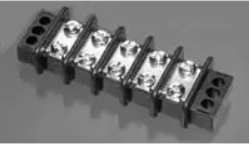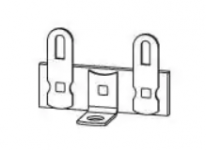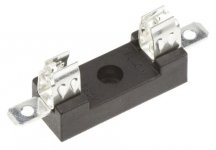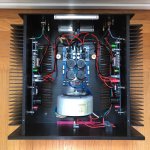For safety, it would be best to secure it in a stable manner and not rely on a soldered connection because of the heat coming off these.
Keep it near some open air circulation as well , maybe some holes under and on the side of the chassis where it mounts.
Is there some reason you can,t use a small terminal block and screwed down tight ?
Regards
David
Keep it near some open air circulation as well , maybe some holes under and on the side of the chassis where it mounts.
Is there some reason you can,t use a small terminal block and screwed down tight ?
Regards
David
Last edited:
For safety, it would be best to secure it in a stable manner and not rely on a soldered connection because of the heat coming off these.
Keep it near some open air circulation as well , maybe some holes under and on the side of the chassis where it mounts.
Is there some reason you can,t use a small terminal block and screwed down tight ?
Regards
David
Good point about the heat and its possible effect on solder joints. I was thinking that although the CL60 gets hot it wouldn't be anywhere near the melting point of solder. However, I agree that it's better to be safe than sorry.
JMFahey said:Unless you have dedicated pads for it on your PCB, the standard answer is a terminal pad ... what else?
You can NOT leave it floating, glue it to anything, etc. ; it´s a critical safety component, which to boot carries live mains voltage.
That's my question: what else is an option? And yes, I'm asking that question because leaving it floating without support isn't acceptable. Maybe I wasn't clear?
A terminal block looks like the most practical, safe option. I was just hoping for an equally safe alternative with better aesthetics.
Thanks for the replies.
Yes, I have used them soldered to tags on the switch and mains connector. Leave the full lead length on. Wrap the wire round the tag for mechanical mounting. Add the solder for electrical connection. Much of the heat will be dissipated by the wire so the solder stays cool enough. If I were making things to sell I would need to find a better way!
There is a difference between a terminal block and a terminal strip. Mouser sells strips but doesn't call them that! They are the gizmos that were the standard way to wire radios etc. before printed circuit boards.
Look at part number 534-810
When Mouser first started selling them it was the first time I had seen them in years. So I bought lots thinking it might be a one time chance. The guys here found them useful and used them up quickly. So I bought even more. They still sell them and it seems every year I buy a few hundred more.
Look at part number 534-810
When Mouser first started selling them it was the first time I had seen them in years. So I bought lots thinking it might be a one time chance. The guys here found them useful and used them up quickly. So I bought even more. They still sell them and it seems every year I buy a few hundred more.
Last edited:
There is a difference between a terminal block and a terminal strip. Mouser sells strips but doesn't call them that! They are the gizmos that were the standard way to wire radios etc. before printed circuit boards.
Look at part number 534-810
When Mouser first started selling them it was the first time I had seen them in years. So I bought lots thinking it might be a one time chance. The guys here found them useful and used them up quickly. So I bought even more. They still sell them and it seems every year I buy a few hundred more.
I've seen those terminal strips -- if I remember correctly there are a couple in the Hafler amp I own.
I've attached a picture of a barrier terminal block with screws and the terminal strip you like.
Attachments
The things with solder tags on an insulating strip, with either some tags extended to form a chassis connection or chassis brackets, are called tag strips in the UK. They come in various lengths, but you can cut or saw them. I have seen one-tag tag strips. Originally they were some sort of bakelite-impregnated multi-layer paper(?) but now they are usually made of some sort of plastic.
No big deal.Our creativity will be enhanced if you show us a picture, or is it a secret?
IF IEC connector AND power switch are near each other, as is usually the case when power switch is in the back panel, THEN at least one leg/tab from switch will be roughly 2"/5cm away from one leg/tab at the connector.
Perfect distance to mount the thermistor across them, with no extra hardware needed; you´ll have to join such tabs anyway with a short piece of wire, you can use the thermistor instead.
Now if they are further away or power switch is in the front panel, then you will need to use a terminal/tag strip.
The kind you solder as shown above, which were invented exactly for this purpose.
No screws involved, no need to, but IF you want to get fancy, why not?
In any case I know nobody doing that.
EDIT:
FR1 , Pertinax ; if memory doesn´t fail it used to be called Paxolin in UKsome sort of bakelite-impregnated multi-layer paper(?)
Last edited:
Yes. I guess I hadn't fully woke up when I posted above and I couldn't remember what we called it.JMFahey said:FR1 , Pertinax ; if memory doesn´t fail it used to be called Paxolin in UK
Yes. I guess I hadn't fully woke up when I posted above and I couldn't remember what we called it.
Here in America the material is called Phenolic, used for terminal strips, tube sockets, and insulators.
...some sort of bakelite-impregnated multi-layer paper(?) but now they are usually made of some sort of plastic.
FR1 , Pertinax ; if memory doesn´t fail it used to be called Paxolin in UK
Here in America the material is called Phenolic, used for terminal strips, tube sockets, and insulators.
Bakelite, a phenolic resin, was developed by Leo Baekeland in Yonkers, New York, and in the US we cling to that word. Pertinax and Paxolin appear to be German and UK brands of about the same stuff. Pure phenolic resin is costly and brittle. It is always cut with a filler. Wood-flour for molded radio cases. Flat-stock is kraft (brown) paper soaked in phenolic.
The generic industry term seems to be FR-1 and FR-2.
While phenolic is a plastic, most popular affordable plastics won't stand soldering or burning parts. Phenolic is old-fashioned and going out of style because the raw liquid is very nasty (however still produced in vast quantity as feed for other chemical production).
------------------
Instead of bare-screw terminal blocks, consider Euro Blocks. Not a whole heap better for mounting a bare-leg thermistor, but on insulated wires a Euro is finger-safe. You should get a few long ones. They cut-up easy. They look like they might melt, and I have done that in a heat-gun. The nylon melted and bubbled so much I could not get the wire or the block out, but it stayed finger-safe.
Last edited:
Yes, I have used them soldered to tags on the switch and mains connector. Leave the full lead length on. Wrap the wire round the tag for mechanical mounting. Add the solder for electrical connection. Much of the heat will be dissipated by the wire so the solder stays cool enough. If I were making things to sell I would need to find a better way!
+1 for the mounting.
It's perfectly OK even for a commercial product, at least from a mechanical stand point: my McIntosh MC240 is more than half a century old, and the mounting is still good. The thermistor itself broke, probably because of the heat, but it still works. I'll add a delayed-on relay to short it out next time I open it up.
+1 for the mounting.
It's perfectly OK even for a commercial product, at least from a mechanical stand point: my McIntosh MC240 is more than half a century old, and the mounting is still good. The thermistor itself broke, probably because of the heat, but it still works. I'll add a delayed-on relay to short it out next time I open it up.
You probably don't need it but personally, I found Rod Elliott thinking useful when I was gathering intel on this subject:
Soft-Start Circuit For Power Amps
Figure 6 is the schematic of his concept. I went for the store's option because of the package deal with the speaker protection circuit. Otherwise, I would have gone for something like the above. Bypassing the thermistor after it's done its job appeals to me. Each to their own. As your experience shows, done right, a straight thermistor can serve for a seriously long time..
Thanks for all the comments and suggestions. In the end I used a terminal block to mount the CL-60. It’s visible in the lower right of the picture with red heat shrink tubing on the legs, which were left long for heat dissipation.
Attachments
- Status
- This old topic is closed. If you want to reopen this topic, contact a moderator using the "Report Post" button.
- Home
- Design & Build
- Construction Tips
- Mount a CL60 without a terminal block?



